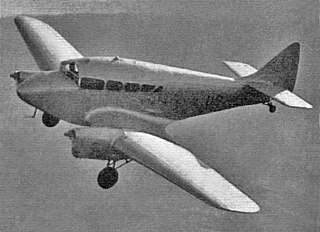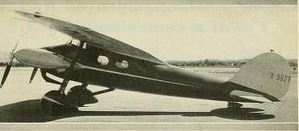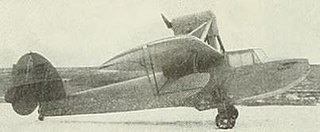
The Aermacchi AL-60 is a light civil utility aircraft of the late 1950s and early 1960s, originally designed by Al Mooney of Lockheed in the United States. After the company decided not to build the aircraft in the US, it was manufactured in small quantities in Mexico, and a few were assembled in Argentina by Aviones Lockheed-Kaiser Argentina. It was also built in quantity under licence by Aermacchi in Italy and Atlas Aircraft Corporation in South Africa.

The Yokosuka R2Y Keiun was a prototype reconnaissance aircraft built in Japan late in World War II.

The Vega Aircraft Corporation was a subsidiary of the Lockheed Aircraft Company in Burbank, California responsible for much of its parent company's production in World War II.

The Lockheed Altair was a single-engined sport aircraft produced by Lockheed Aircraft Limited in the 1930s. It was a development of the Lockheed Sirius with a retractable undercarriage, and was the first Lockheed aircraft and one of the first aircraft designs with a fully retractable undercarriage.

The PZL.44 Wicher (gale) was a prototype of 14-seat, twin-engine Polish airliner, built in the Państwowe Zakłady Lotnicze (PZL) in 1938. It was to compete with the DC-2 and Lockheed Super Electra.

PZL.26 was a Polish sports plane built in 1934 by the Państwowe Zakłady Lotnicze. Ordered by the Ministry of Defence, it was specifically designed for the upcoming Challenge 1934 International Touring Aircraft Contest.

The Savoia-Marchetti SM.91 was a two-seat, twin-engined, Italian heavy fighter prototype, designed to compete in a 1942 revision to a long-range fighter-bomber contract offered by the Regia Aeronautica to Italian aircraft companies in 1938. The original 1938 specification yielded the Savoia-Marchetti SM.88, which the SM.91 was largely based on.

The Miles M.8 Peregrine was a 1930s British twin-engined monoplane light transport designed by Miles Aircraft Limited. A promising design, the Peregrine never entered production as the company was preoccupied by fulfilling orders for other types to the RAF. Only two of the model were built, one prototype M.8 Peregrine, and one modified M.8A Peregrine II which was used for experimentation work at Royal Aircraft Establishment.
The Piper PA-6 Sky Sedan was a 1940s American four-seat light aircraft designed and built in prototype form by Piper Aircraft at its Lock Haven, Pennsylvania, factory.

The Lockheed L-1649 Starliner is the last model of the Lockheed Constellation line of airliners. Powered by four Wright R-3350 TurboCompound engines, it was built at Lockheed's Burbank, California plant from 1956 to 1958.

The Fieseler Fi 99 Jungtiger was a German sports aircraft prototype, produced by Fieseler company. The aircraft was a low-wing two-seat aircraft with an enclosed cabin. It was powered by a Hirth HM 506A engine, producing 160 hp (119 kW).

The Gotha Go 150 was a light aircraft designed at the German company Gothaer Waggonfabrik in the late 1930s. It was intended for civilian use, but ended up being used as a military trainer.

The Lockheed L-1249 Super Constellation was a turboprop-powered version of the Lockheed Constellation aircraft family. Built in 1954 and 1955, the aircraft were used as prototypes for possible future military transport aircraft for both the United States Air Force and United States Navy. Both aircraft saw very short lives and the airframes were later used to build L-1049 Super Constellations.

The Partenair Mystere is a Canadian two-seat, pusher configuration monoplane that was designed by Partenair Design of Saint-Jean-sur-Richelieu, Quebec and intended for amateur construction from kits.

The Menasco Unitwin 2-544 was a coupled piston engine. Menasco Motors Company of Burbank, California was a well known manufacturer of inverted inline four and six cylinder engines. At the request of Lockheed Aircraft designers, Menasco produced an inverted twelve-cylinder air cooled aircraft engine by designing a common crankcase and gearbox for two of the six cylinder engines. The two crankshafts were combined with a unique double clutch gearbox to power a single propeller. This gave reliability of a twin engine aircraft in a single powerplant. It was a success, but did not enter production as no aircraft were produced that used it.
The Microleve ML 450 is a Brazilian microlight aircraft that was designed and produced by Microleve of Rio de Janeiro. When it was available the aircraft was supplied as a complete ready-to-fly-aircraft or as a kit for amateur construction.

The Rowley P-40F was an American homebuilt aircraft that was designed by Richard J Rowley and marketed by his company 76th Fighter Squadron Inc, of Meadow Lake Airport, Colorado, first flown in 1986. When it was available the aircraft was supplied in the form of plans for amateur construction.
The Vortech Shadow is an American autogyro that was designed by Tyler Flight, Inc. and produced by Vortech of Fallston, Maryland. The aircraft is supplied as a kit and also in the form of plans for amateur construction. Vortech also supplies rotor blades for the design.

The Alcor Duo-4 was a high wing cabin aircraft, unusually powered by a pair of four cylinder straight engines mounted horizontally either side of the nose. After an accident it was rebuilt with six cylinder engines, becoming the Alcor Duo-6. The name Alcor derived from Allan Lockheed Corporation.

The Argonaut Pirate was a 1930s, U.S., three place, single-engined pusher configuration amphibious aircraft. Only two were built.


















